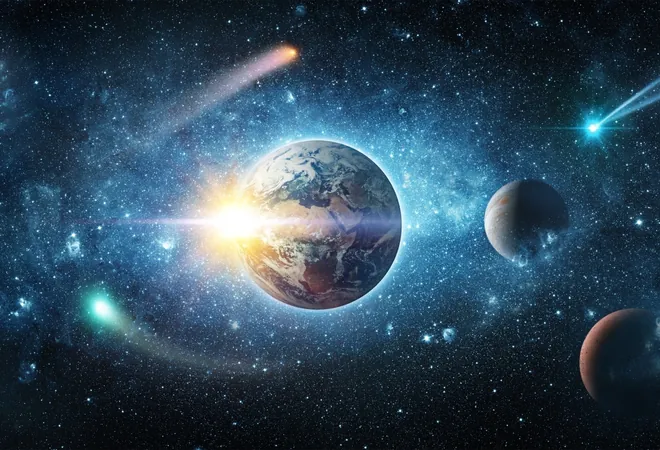
Unlocking the Secrets of Asteroid Colors: A Journey to Our Solar System's Origins
2025-08-29
Author: Rajesh
Asteroids have been drifting through the cosmos since long before Earth was even a thought in the universe's grand design. These ancient celestial wanderers hold the key to unraveling the mysteries of our solar system's formation, and scientists are finally getting their hands on some of these cosmic treasures.
The Color-Changing Enigma of Asteroids
Have you ever gazed at asteroids through a telescope and wondered why some appear red while others shimmer in shades of blue, despite being composed of the same materials? This intriguing difference has left astronomers scratching their heads. The varied colors are not just for show; they provide critical insights into the asteroids' compositions without the need for space travelers to visit each one.
A Cosmic Makeover: Space Weathering
The answer to this colorful conundrum lies in a phenomenon known as space weathering. Just as a copper penny tarnishes or paint fades under the sun, asteroids undergo surface changes due to bombardments from radiation, micrometeorites, and the solar wind. Surprisingly, it's not the type of weathering that causes the color differences but rather the timing of the exposure.
Timelines of Transformation
Michelle Thompson, an associate professor at Purdue University, has dedicated her research to understanding how these rocky bodies evolve in the harsh environment of space. Her insights shed light on the chemical origins of the early solar system.
“Sample return missions are a cornerstone of planetary science,” Thompson explains. “They offer us crucial snapshots of the chemistry and composition from the dawn of our solar system, allowing us to examine the building blocks of planets.”
Bennu vs. Ryugu: A Tale of Two Asteroids
The breakthrough in understanding came when researchers analyzed samples from the asteroid Bennu and compared them with those from Ryugu, a celestial companion visited by Japan's Hayabusa missions. Both asteroids are classified as "rubble pile" asteroids—essentially cosmic junk heaps—composed of carbon-rich materials and formed approximately 4.6 billion years ago.
But here's the twist: despite their similarities, Ryugu exhibits a reddish hue while Bennu appears blue. This initially suggested a difference in how they weather in space, but the collected samples revealed a more intriguing story.
A Cosmic Clock Reveals Color Changes
It turns out that the colors reflect the asteroids' different stages in a shared aging process. The surfaces of these rubble piles are constantly shifting, revealing fresh material beneath. Surface grains from Ryugu have been exposed to space for only a few thousand years, while Bennu's grains have endured the harsh elements for tens of thousands of years. This means they represent different timelines in an ongoing cycle of aging.
“Instead of witnessing two distinct paths of erosion, we’re observing two moments in the same aging journey,” Thompson clarifies. “Their colors indicate their spectral properties have changed based on how long they’ve been exposed to space.”
Bennu: A Cosmic Treasure Chest
The analysis of Bennu's samples has unearthed another exciting revelation: the presence of salts, including phosphates essential for life on Earth. These compounds are key to metabolic processes and form the backbone of DNA.
Scientists discovered evidence of ancient brine, saltwater conditions perfectly suited for the chemical reactions believed to lead to life. In essence, Bennu is like a cosmic recipe book, offering insight into the foundational ingredients necessary for life.
Time Capsules of the Early Universe
What sets these samples apart is their age and pristine condition. Earth has recycled its materials for billions of years, leading to a melange of ingredients. In contrast, Bennu's samples have remained untouched in the cosmic freezer for 4.6 billion years, akin to finding a perfectly preserved dish from the very first restaurant in the universe.
“Asteroids are relics of the early solar system,” Thompson states. “They serve as time capsules, allowing us to explore both the origins of our solar system and the beginnings of life on Earth.”
The Future of Asteroid Exploration
Research on Bennu has unveiled its diverse materials derived from across the solar system and possibly beyond, transformed through water and space weathering over eons. As we forge ahead with space exploration, understanding the relationship between asteroid colors and their surfaces will provide invaluable guidance for selecting targets. The vibrant hues of these asteroids are not just visually stunning—they are vital keys to unlocking the past and future of our solar system.

 Brasil (PT)
Brasil (PT)
 Canada (EN)
Canada (EN)
 Chile (ES)
Chile (ES)
 Česko (CS)
Česko (CS)
 대한민국 (KO)
대한민국 (KO)
 España (ES)
España (ES)
 France (FR)
France (FR)
 Hong Kong (EN)
Hong Kong (EN)
 Italia (IT)
Italia (IT)
 日本 (JA)
日本 (JA)
 Magyarország (HU)
Magyarország (HU)
 Norge (NO)
Norge (NO)
 Polska (PL)
Polska (PL)
 Schweiz (DE)
Schweiz (DE)
 Singapore (EN)
Singapore (EN)
 Sverige (SV)
Sverige (SV)
 Suomi (FI)
Suomi (FI)
 Türkiye (TR)
Türkiye (TR)
 الإمارات العربية المتحدة (AR)
الإمارات العربية المتحدة (AR)